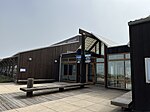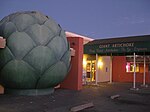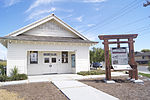Salinas River (California)

The Salinas River (Rumsen: ua kot taiauačorx) is the longest river of the Central Coast region of California, running 175 miles (282 km) and draining 4,160 square miles (10,800 km2). It flows north-northwest and drains the Salinas Valley that slices through the central California Coast Ranges south of Monterey Bay. The river begins in southern San Luis Obispo County, originating in the Los Machos Hills of the Los Padres National Forest. From there, the river flows north into Monterey County, eventually making its way to connect with the Monterey Bay, part of the Pacific Ocean, approximately 5 miles (8.0 km) south of Moss Landing. The river is a wildlife corridor, and provides the principal source of water from its reservoirs and tributaries for the farms and vineyards of the valley.
Excerpt from the Wikipedia article Salinas River (California) (License: CC BY-SA 3.0, Authors, Images).Salinas River (California)
Monterey Dunes Way,
Geographical coordinates (GPS) Address Nearby Places Show on map
Geographical coordinates (GPS)
| Latitude | Longitude |
|---|---|
| N 36.749444444444 ° | E -121.80361111111 ° |
Address
Salinas River Mouth Natural Preserve
Monterey Dunes Way
95039
California, United States
Open on Google Maps







